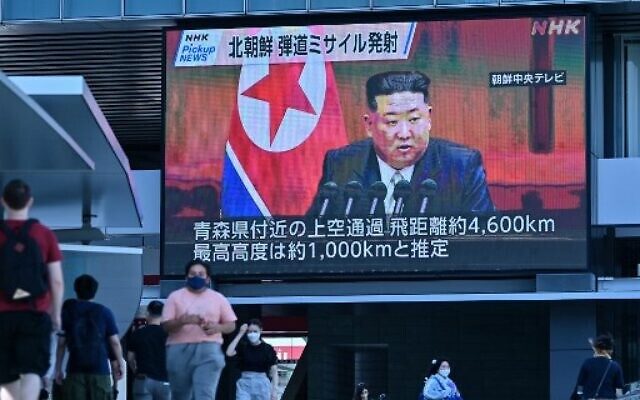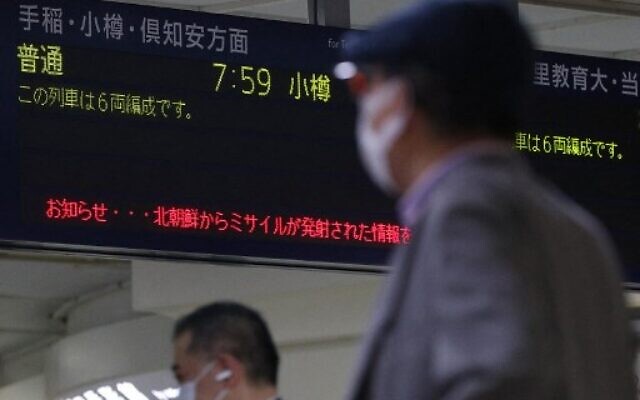North Korea fired an intermediate-range ballistic missile over Japan on Tuesday, prompting Tokyo to activate the country’s missile alert system and order people to take shelter.
The last time North Korea fired a missile over Japan was in 2017, at the height of a period of “fire and fury” when Pyongyang’s leader Kim Jong Un traded insults with then-US president Donald Trump.
South Korea’s military said it had detected the launch of an IRBM, which flew around 4,500 kilometers (2,800 miles) at an altitude of about 970 kilometers and a speed of around Mach 17.
The missile’s flight distance shows it has enough range to hit the US Pacific territory of Guam, home to US military bases that sent advanced warplanes to the Korean Peninsula in shows of force in past tensions with North Korea.
“Specific details are under close analysis by South Korean and US intelligence,” the South’s Joint Chiefs of Staff added in a statement.
Get The Times of Israel's Daily Edition by email and never miss our top stories
South Korea’s President Yoon Suk-yeol called the launch a “provocation” that violated UN regulations.

Pedestrians walk under a large video screen showing images of North Korea’s leader Kim Jong Un during a news update after Pyongyang conducted a missile test that forced residents in Japan to seek shelter, Tokyo, October 4, 2022. (Richard A. Brooks/AFP)
Yoon “ordered a stern response and to take corresponding measures in cooperation with the United States and the international community,” his office said in a statement.
North Korea was not responding to routine daily contact on the inter-Korean liaison line Tuesday, Seoul’s unification ministry said.
Tokyo also confirmed the launch of an IRBM, activating the country’s missile alert warning system and urging people to take shelter.
“North Korea appears to have launched a missile. Please evacuate into buildings or underground,” the government said in an alert issued at 7:29 am (2229 GMT Monday).
Trains were suspended in the Hokkaido and Aomori regions until the government issued a subsequent notice that the North Korean missile appeared to have landed in the Pacific. In Sapporo city, the prefectural capital of Japan’s northernmost main island of Hokkaido, subways were also temporarily suspended, with stations packed with morning commuters.
Prime Minister Fumio Kishida told reporters that the launch was “an act of violence following recent repeated launches of ballistic missiles. We strongly condemn this.”
Defense Minister Yasukazu Hamada said that North Korea “has in the past launched Hwasong 12-type missiles four times, so this could be the same type.”
If so, the flight distance, which Tokyo estimated at 4,600 kilometers, was thought to be a new record for that particular type of missile.

People walk past an electronic bulletin board notifying passengers of a disruption to the timetable following a missile launch by North Korea, at a railway station in Sapporo, Hokkaido prefecture on October 4, 2022. (JIJI Press/AFP)
The last two times North Korea fired Hwasong-12 missiles over Japan, in September and August 2017, they traveled 3,700 kilometers and 2,700 kilometers respectively, Chad O’Carroll of Seoul-based specialist site NK News wrote on Twitter.
“This is the 8th test of the Hwasong-12 and the 3rd time it has overflown Japan,” Jeffrey Lewis of the Middlebury Institute of International Studies wrote on Twitter.
Washington condemned the launch, with US National Security Adviser Jake Sullivan speaking to his counterparts in Seoul and Tokyo to discuss an “appropriate and robust” joint response.
“Sullivan reinforced the United States’ ironclad commitments to the defense of Japan and the ROK (South Korea),” national security spokeswoman Adrienne Watson said in a statement.
Military drills
With talks long-stalled, nuclear-armed North Korea has doubled down on Kim’s military modernization plans this year, testing a string of banned weaponry, including an intercontinental ballistic missile (ICBM) also for the first time since 2017.
Last week, Pyongyang fired short-range ballistic missiles on four occasions, including just hours after US Vice President Kamala Harris flew out of Seoul.
Pyongyang’s latest bout of intense weapons testing comes as Seoul, Tokyo and Washington ramp up joint military drills to counter growing threats from the North.
South Korea, Japan, and the United States staged anti-submarine drills Friday — the first in five years — just days after Washington and Seoul’s navies conducted large-scale exercises in waters off the peninsula, involving a nuclear-powered US aircraft carrier.
Such drills infuriate North Korea, which sees them as rehearsals for an invasion.

US Vice President Kamala Harris (C) is briefed by troops at a military operation post during her visit to the demilitarized zone (DMZ) separating North and South Korea, in Panmunjom on September 29, 2022. (Leah MILLIS/POOL/AFP)
Harris toured the heavily fortified Demilitarized Zone that divides the peninsula while on a trip that aimed to underscore her country’s “ironclad” commitment to South Korea’s defense against the North.
Washington has stationed about 28,500 troops in South Korea to help protect it from the North.
Significant escalation
Firing a missile over Japan represented a “significant escalation” by North Korea, said Leif-Eric Easley, a professor at Ewha University in Seoul.
“Pyongyang is still in the middle of a provocation and testing cycle,” he added. “The Kim regime is developing weapons such as tactical nuclear warheads and submarine-launched ballistic missiles as part of a long-term strategy to outrun South Korea in an arms race and drive wedges among US allies.”
South Korean and US officials have also been warning for months that Kim is preparing to conduct another nuclear test, saying last week that this could happen soon after China’s upcoming party congress on October 16.
North Korea, which is under multiple UN sanctions for its weapons programs, typically seeks to maximize the geopolitical impact of its tests with careful timing.
The isolated country has tested nuclear weapons six times since 2006, most recently in 2017.


